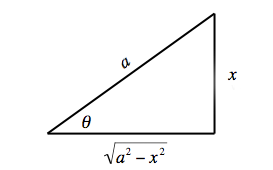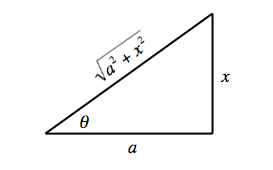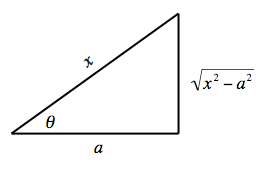| =\int\frac{a\sec\theta\tan\theta\mathrm d\theta}{a>\tan\theta|} | =\begin{cases}
\displaystyle\int\sec\theta\mathrm d\theta&x>a\\
\displaystyle-\int\sec\theta\mathrm d\theta&x<-a
\end{cases}=\begin{cases}
\displaystyle\ln|\sec\theta+\tan\theta|+C&x>a\\
\displaystyle-\ln|\sec\theta+\tan\theta|+C'&x<-a
\end{cases}
|-
|
|}
이 적분은 쌍곡 치환 를 통해서도 구할 수 있다.
와 같은 정적분은 치환 후 적분 구간을 변경하여 계산한다.[6]
만약 일 경우 이므로 이며, 만약 일 경우 이므로 이다. 따라서 다음이 성립한다.
:
3. 1. 을 포함하는 적분
다음과 같은 적분을 구할 수 있다.[7][9]
:
여기서 이다. 다음과 같은 삼각 치환을 사용한다.
:
그러면 다음을 얻는다.
| | (치환) |
| | (단순화) |
| | (적분) |
| | (재치환) |
이 적분은 와 같은 치환과 아크사인의 도함수를 통해서도 구할 수 있다.
위와 똑같은 삼각 치환을 통해 다음과 같은 적분을 구할 수 있다.[9]
| | (치환) |
| | (삼각 항등식) |
| | (적분) |
| | (삼각 항등식) |
| | (재치환) |
| | (단순화) |
이 적분은 부분 적분을 통해서도 구할 수 있다.
에서 를 사용할 수 있다.
그러면,
위 단계에서는 그리고 이어야 한다. 를 의 주 제곱근으로 선택하고, 역 사인 함수를 사용하여 의 제한을 가할 수 있다.
정적분의 경우, 적분 경계가 어떻게 변하는지 알아야 한다. 예를 들어, 가 에서 로 변하면, 는 에서 로 변하고, 따라서 는 에서 로 변한다. 그러면,
경계를 선택할 때 주의가 필요하다. 위 적분은 를 요구하기 때문에 는 에서 까지만 변할 수 있다. 이 제한을 무시하면, 가 에서 로 변한다고 선택할 수 있는데, 이 경우 실제 값의 음수가 결과로 나올 것이다.
또는, 경계 조건을 적용하기 전에 부정 적분을 완전히 평가할 수 있다. 이 경우, 부정 적분은
이다.
는 로 놓음으로써 계산할 수 있으며, 여기서 이므로 이고, 는 아크사인 범위이므로 이고 이다.
그렇다면,
정적분의 경우, 치환이 수행되면 경계가 바뀌고, 방정식 를 사용하여 범위 에서 값을 결정한다. 또는 경계 조건을 부정적분 공식에 직접 적용할 수도 있다.
예를 들어, 정적분
는 로 치환하여 계산할 수 있으며, 경계는 를 사용하여 결정된다.
이고 이므로
반면에, 경계 조건을 앞에서 얻은 부정적분 공식에 직접 적용하면 다음과 같다.
앞서와 같다.
3. 2. 을 포함하는 적분
: ()를 구하기 위해 다음 치환을 사용한다.[7]
:
그러면 다음을 얻는다.
| | (치환) |
| | (단순화) |
| | (적분) |
| | (재치환) |
이 적분은 로 치환 및 아크탄젠트의 도함수를 통해서도 구할 수 있다. 위와 똑같은 삼각 치환을 통해 다음과 같은 적분을 구할 수 있다.[9]
| | (치환) |
| | (단순화) |
| | (변형) |
| | (치환) |
| =\frac 12\ln\left>\frac{1+\sin\theta}{1-\sin\theta}\right|+C | (적분) |
| =\frac 12\ln\left>\frac{1+\sin\theta}{\cos\theta}\right|^2+C | (삼각 항등식) |
| =\ln\left>\sec\theta+\tan\theta\right|+C | (삼각 항등식) |
| =\ln\left>\frac{\sqrt{a^2+x^2}}a+\frac xa\right|+C | (재치환) |
| =\ln\left>x+\sqrt{a^2+x^2}\right|+C | (적분 상수 재정의) |
이 적분은 쌍곡 치환 을 통해서도 구할 수 있다.
정적분의 경우, 치환이 수행되면 경계가 바뀌며, 를 사용하여 범위 내의 값으로 결정된다. 또는, 경계 조건을 부정적분의 공식에 직접 적용할 수 있다.
예를 들어, 정적분 은 를 치환하여 계산할 수 있으며, 경계는 를 사용하여 결정된다.
이고 이므로, 다음이 성립한다.
한편, 경계 조건을 부정적분의 공식에 직접 적용하면 이전과 동일한 결과를 얻는다.
적분 은 로 치환하여 구할 수 있다.
여기서 이므로 이고, 아크탄젠트의 범위에 의해 이므로 이고 이다.
그러면, 다음을 얻는다.
시컨트 세제곱의 적분은 부분 적분법을 사용하여 계산할 수 있다. 결과적으로, 다음을 얻는다.
3. 3. 을 포함하는 적분
편의상 <math>x>0</math>이라고 하고 <math>a>0</math>일 때 다음 적분을 구한다.[7]
:
이때 다음 치환을 사용한다.
:
그러면 다음을 얻는다.
| =\int\frac{a\sec\theta\tan\theta\mathrm d\theta}{a^2\sec\theta>\tan\theta|} |
| style="padding-left: 1em;" |(치환)
|-
|
|
| style="padding-left: 1em;" |(단순화)
|-
|
|
| style="padding-left: 1em;" |(적분)
|-
|
|
| style="padding-left: 1em;" |(재치환)
|}
이 적분은 치환 <math>x/a=t</math> 및 아크시컨트의 도함수를 통해서도 구할 수 있다.
위와 똑같은 삼각 치환을 통해 다음 적분도 구할 수 있다.[9]
:
| =\int\frac{a\sec\theta\tan\theta\mathrm d\theta}{a>\tan\theta|} |
| style="padding-left: 1em;" |(치환)
|-
|
|
| style="padding-left: 1em;" |(단순화)
|-
|
|
| style="padding-left: 1em;" |(적분)
|-
|
|
| style="padding-left: 1em;" |(재치환)
|-
|
|
| style="padding-left: 1em;" |(적분 상수 재정의)
|}
이 적분은 쌍곡 치환 <math>x=a\cosh t</math>를 통해서도 구할 수 있다.
3. 4. 정적분
와 같은 정적분은 치환 후 적분 구간을 변경하여 계산한다.[6]
만약 일 경우 이므로 이며, 만약 일 경우 이므로 이다. 따라서 다음이 성립한다.
:
4. 쌍곡 치환
치환을 이용해 적분을 간단하게 할 수 있다.[4]
예를 들어, 를 적분하기 위해 ()로 치환하고, 항등식 을 사용하면 다음을 얻는다.
원한다면, 이 결과는 관계식 을 사용하는 등 다른 항등식을 사용하여 추가로 변환할 수 있다.
5. 삼각 함수를 제거하는 치환
바이어슈트라스 치환과 같은 방법을 사용하여, 삼각 함수를 포함하는 적분을 유리 함수 적분으로 변환할 수 있다.
예를 들어,
:
마지막 치환은 바이어슈트라스 치환으로 알려져 있으며, 반각 공식을 사용한다.
예를 들어,
:
본 사이트는 AI가 위키백과와 뉴스 기사,정부 간행물,학술 논문등을 바탕으로 정보를 가공하여 제공하는 백과사전형 서비스입니다.
모든 문서는 AI에 의해 자동 생성되며, CC BY-SA 4.0 라이선스에 따라 이용할 수 있습니다.
하지만, 위키백과나 뉴스 기사 자체에 오류, 부정확한 정보, 또는 가짜 뉴스가 포함될 수 있으며, AI는 이러한 내용을 완벽하게 걸러내지 못할 수 있습니다.
따라서 제공되는 정보에 일부 오류나 편향이 있을 수 있으므로, 중요한 정보는 반드시 다른 출처를 통해 교차 검증하시기 바랍니다.
문의하기 : help@durumis.com


